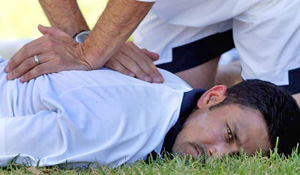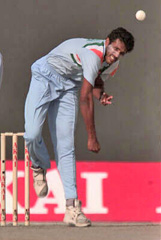COACHING
Physiotherapy in Cricket
The science of Ergonomy aims to balance the productivity of a player with his physical and mental well-being. There are three key elements in attaining this delicate balance;The player
The physio
The coach
To maintain a healthy and productive existence in sports, the physio is the pathfinder.
Physiotherapy can be defined as the science of physical rehabilitation, and the primary goal of a physio is to help the players overcome muscular, skeletal and neurological problems, and in doing so, help them achieve complete fitness.

Anil Kumble being attended to by the physio
Physiotherapists need to have all the proper
qualifications. They should be well-versed in the
assessment and treatment of soft-tissue injuries. A
large number of the sports injuries that they
encounter call for a comprehensive knowledge of
biomechanics, tissue pathology and the healing
process. The physio of a cricket team provides
fitness programmes for the players and monitors the
rehabilitation of injured players, keeping their
careers in mind. The physio can provide enormous
relief to injured players with his quick-start
programme and on-ground treatment. Immediate access
to treatment services for sports injuries has been
shown to have significantly accelerated the healing
process and allowed for the early return of the
player to regular training and active
participation.
Most sports injuries occur in soft tissues (sprain, strains, contusions or joint inflammation). A physio has to be on his toes throughout the game. A good physio will be able to diagnose and assess the nature of the injury and its severity on the ground itself, and start treating and managing it immediately.
Let me narrate an incident that took place in the 1999-00 season, during a Ranji Trophy game between Karnataka and Mumbai. I was the physio of the Mumbai squad. On the third day, some 15 minutes after the tea-break, Abey Kuruvilla, one of the finest fast bowlers to represent Mumbai and India, twisted his left ankle while bowling his third spell of the day.

Abey Kuruvilla
I attended to him and realized that the ligament
had been overstretched, i.e: what we describe in
medical parlance as a 'first-degree sprain of the
talo-fibular ligament'. It was difficult to decide
whether to get him to carry on or to take him off
the field and treat him. After talking to Sameer
Dighe, the captain, I took the responsibility of
taking him off and making him ready to bowl flat
out the next day, the last of the match. We needed
Abey to be at his best the next day as we had to
take eight more wickets to win the game. For two
hours, I applied ice on the injured area for 10
minutes, then took a 10 minutes break, then applied
ice again for ten minutes, and so on. The idea was
to prevent swelling. During this two-hour exercise
and another whole hour, I kept his leg elevated at
an angle of 30 - 40 degrees, which helped remove
accumulated fluid from the area. After that, I used
physiotherapy machines and equipment with anti-
inflammatory ointments and taped the injured area
for the night.
When we checked the ankle the next morning, we could not find any swelling or pain. I asked him to walk and do some slow stretches (as there was some stiffness) and weight-bearing exercises. The left ankle of a right-arm fast bowler bears the maximum weight of the body, just before the ball is released, and Abey being a right-hander, it was critical for him to feel confident that his ankle was in proper, 'playable' condition. He said that he was feeling okay. We applied ice for around 10 minutes and I then strapped his ankle. Abey took the field, and the ball. He bagged five wickets in the first session itself and we went on to win. Had I not taken the responsibility and allowed him to play the previous afternoon, the injury might well have aggravated and turned into a second-degree sprain or tear of a ligament, which would have rendered him unfit for atleast 3-4 weeks, and the period of recovery and recuperation would have been much more.